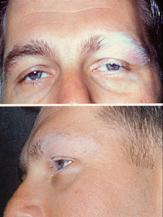Vogt-Koyanagi-Harada syndrome
| Vogt–Koyanagi–Harada disease | |
|---|---|
 |
|
| Dermatologic manifestation of VKH | |
| Classification and external resources | |
| Specialty | ophthalmology |
| ICD-10 | H20.8 H30.8 |
| Orphanet | 3437 |
Vogt–Koyanagi–Harada disease (VKH), also known as Vogt–Koyanagi–Harada syndrome, uveomeningitis syndrome and uveomeningoencephalitic syndrome, is a multisystem disease of presumed autoimmune cause, that affects pigmented tissues, which have melanin. The most significant manifestation is bilateral, diffuse uveitis, which affects the eye. VKH may variably also involve the inner ear with effects on hearing, the skin, and the meninges of the central nervous system.
The disease is characterised by bilateral diffuse uveitis, with pain, redness and blurring of vision. The eye symptoms may be accompanied by a varying constellation of systemic symptoms, such as auditory (tinnitus,vertigo, and hypoacusis), neurological (meningismus, with malaise, fever, headache, nausea, abdominal pain, stiffness of the neck and back, or a combination of these factors;meningitis,CSF pleocytosis, cranial nerve palsies, hemiparesis, transverse myelitis and ciliary ganglionitis), and cutaneous manifestations, including poliosis, vitiligo, and alopecia. The vitiligo often is found at the sacral region.
The sequence of clinical events in VKH is divided into four phases: prodromal, acute uveitic, convalescent, and chronic recurrent.
The prodromal phase may have no symptoms, or may mimic a non-specific viral infection, marked by flu-like symptoms that typically last for a few days. There may be fever, headache, nausea, meningismus, dysacusia (discomfort caused by loud noises or a distortion in the quality of the sounds being heard), tinnitus, and/or vertigo. Eye symptoms can include orbital pain, photophobia and tearing. The skin and hair may be sensitive to touch.Cranial nerve palsies and optic neuritis are uncommon.
...
Wikipedia
